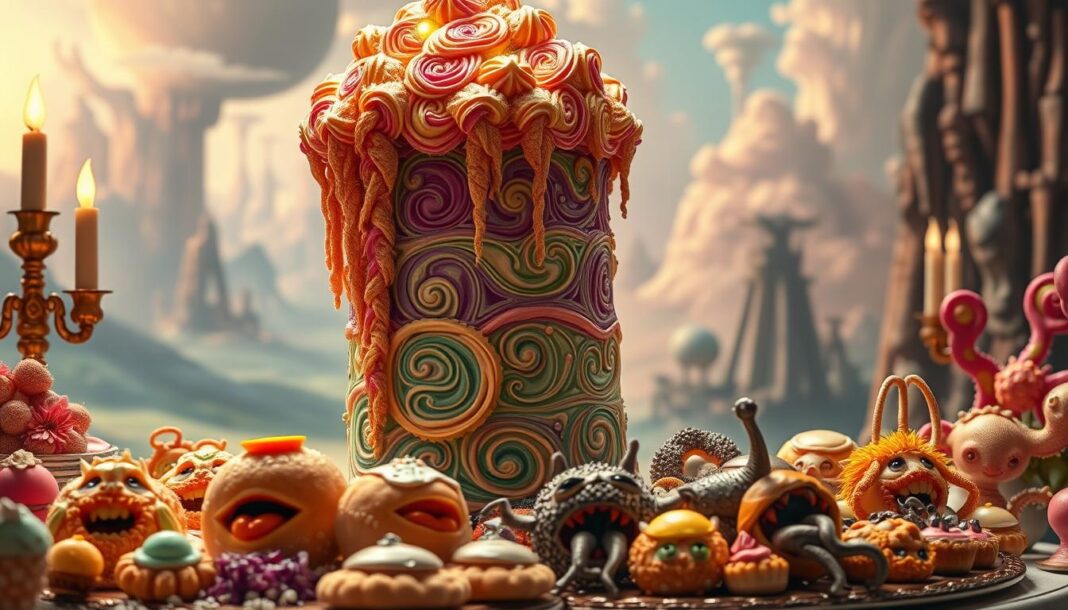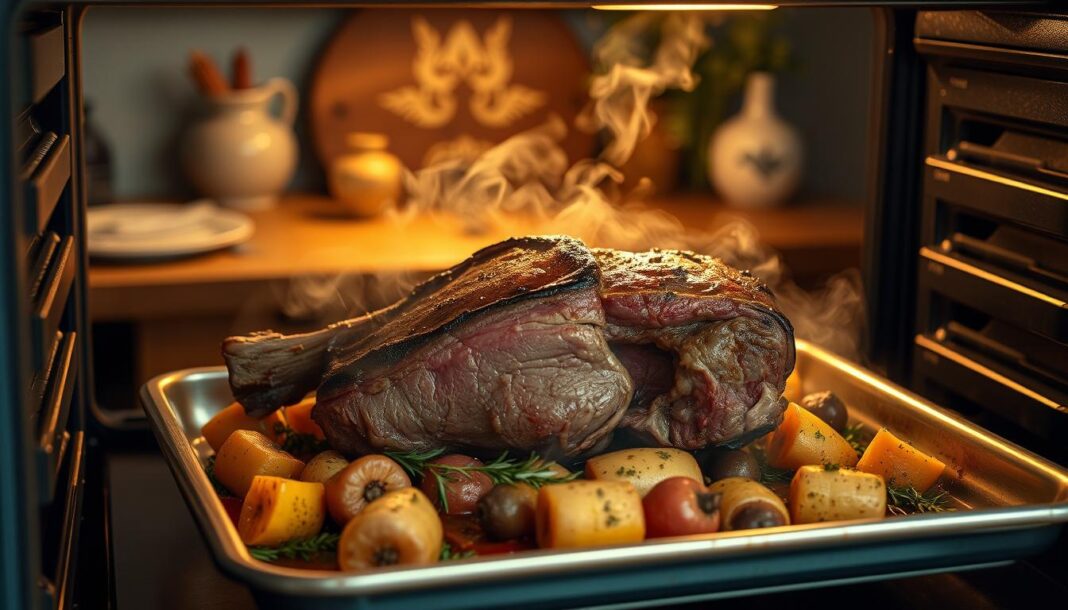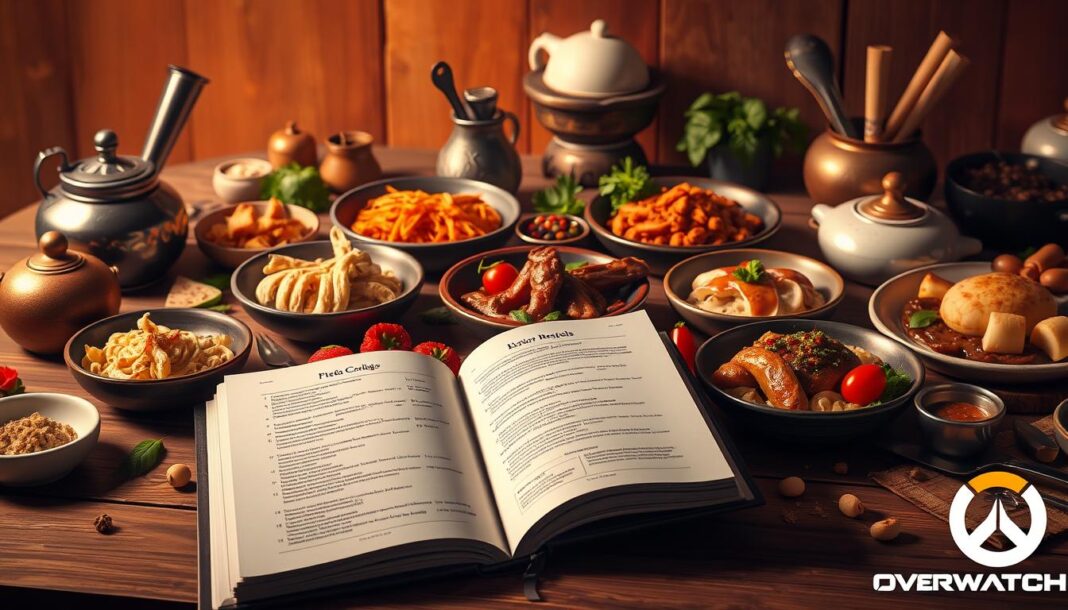We often find ourselves captivated by the fictional foods that appear in our favorite books, movies, and TV shows. These culinary creations not only tantalize our taste buds but also transport us to new worlds, sparking our imagination.
As we explore the science behind these imaginary dishes, we uncover the intricate way that food is used as a storytelling device. By examining the chemistry and psychology behind these fictional feasts, we gain insight into why they resonate with us on a deep level, evoking a particular taste that lingers long after the story ends.
Our journey through the realm of fictional cuisine will reveal how these creations reflect our cultural values and culinary aspirations, shaping the food we eat and the way we experience it.
Key Takeaways
- Exploring the science behind fictional foods and their impact on our imagination.
- Understanding how fictional foods are used as storytelling devices.
- Analyzing the chemistry and psychology that make fictional foods appealing.
- Examining the reflection of cultural values and culinary aspirations in fictional foods.
- Discovering how fictional foods influence real-world cuisine and culinary innovation.
The Fascination with Food in Fiction
The fascination with food in fiction is a multifaceted phenomenon that not only reflects our current culinary landscape but also inspires future innovations. We explore how fictional foods capture our imagination and their cultural impact.
Why Fictional Foods Capture Our Imagination
Fictional foods often tap into our desires and nostalgia, creating a deep emotional connection with audiences. These imaginary dishes can symbolize comfort, joy, or even rebellion, resonating with readers and viewers on a personal level. By examining these foods, we gain insight into the cultural and social contexts of different time periods.
The Cultural Impact of Imaginary Cuisines
Imaginary cuisines have a significant food culture impact, influencing real-world culinary trends and inspiring chefs and food enthusiasts alike. They can become cultural touchstones, symbolizing the creativity and innovation of their respective fictional worlds. This cultural significance underscores the power of fictional foods to shape our perceptions and experiences of cuisine.
| Aspect | Description | Impact |
|---|---|---|
| Culinary Inspiration | Fictional foods inspire real-world culinary innovations. | New recipes and dishes emerge from fictional concepts. |
| Cultural Significance | Imaginary cuisines become cultural touchstones. | They influence food culture and societal perceptions. |
| Emotional Connection | Fictional foods evoke emotions and nostalgia. | Audiences form personal connections with imaginary dishes. |
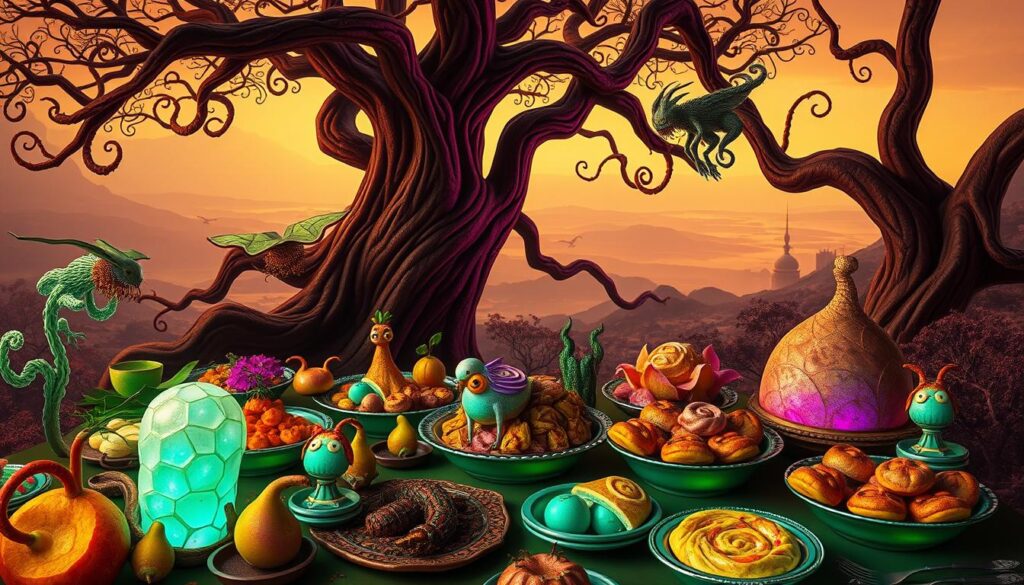
Willy Wonka’s Edible Inventions
Willy Wonka’s inventions are not just mere candies; they are gateways to a world of pure imagination. The Willy Wonka chocolate factory is a place where the boundaries of food and fantasy blur, creating treats that are as intriguing as they are delicious.
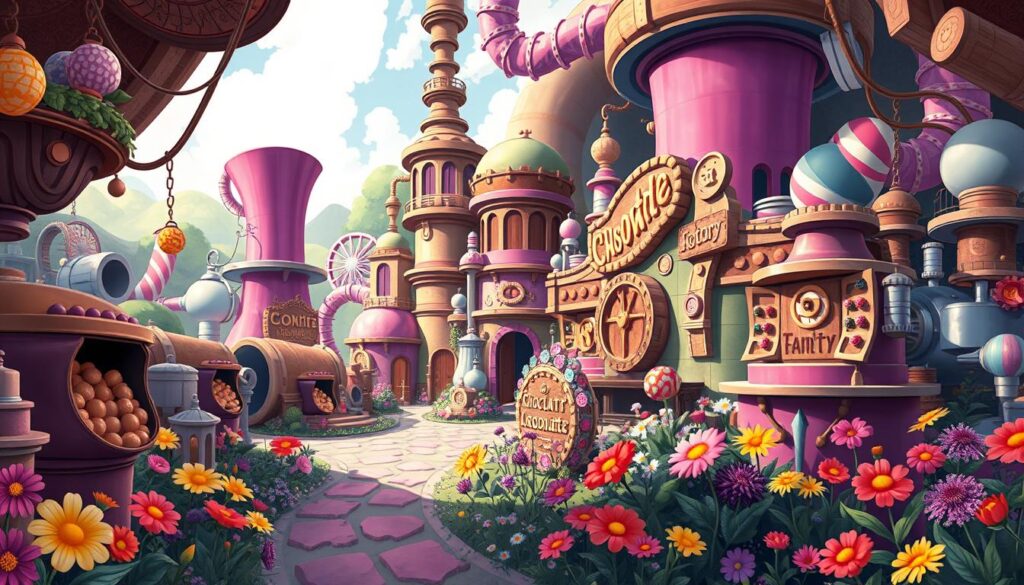
Everlasting Gobstoppers and Lickable Wallpaper
Wonka’s Everlasting Gobstoppers and Lickable Wallpaper showcase his innovative approach to candy-making. The Everlasting Gobstopper, with its multiple layers of flavor, represents a marvel of texture and taste manipulation, while the Lickable Wallpaper pushes the boundaries of interactive confectionery.
Three-Course Dinner Gum and Fizzy Lifting Drinks
The Three-Course Dinner Gum and Fizzy Lifting Drinks are testaments to Wonka’s creativity in reimagining the concept of a meal. The three-course dinner gum, with its changing flavors, embodies the ultimate convenience food fantasy, while the Fizzy Lifting Drinks, inspired by real carbonation science, offer a fizzy twist on traditional beverages, making them a fascinating example of Wonka’s innovative spirit in the Wonka chocolate factory.
Magical Meals from the Wizarding World
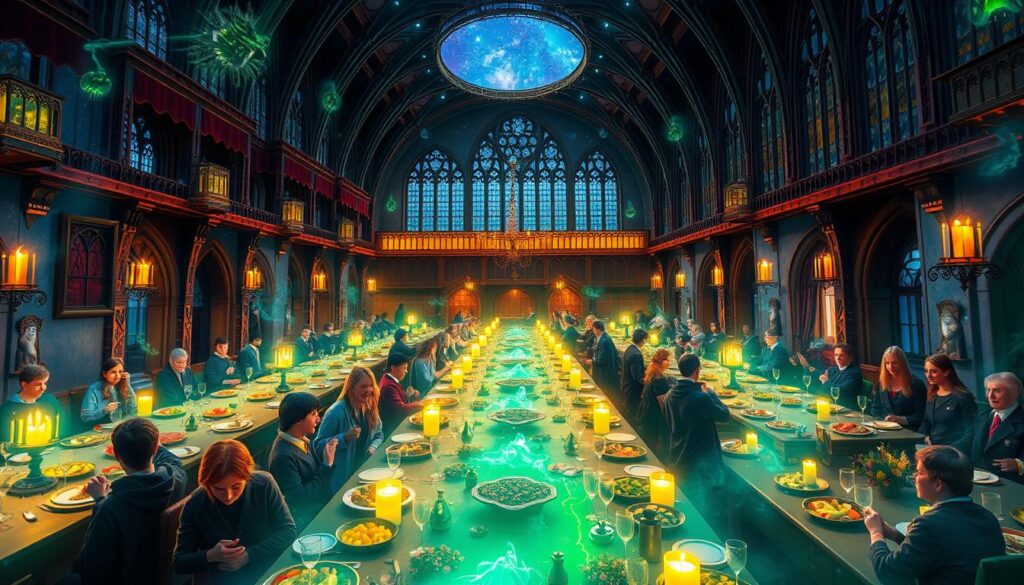
In the Harry Potter series, food plays a pivotal role, not just as a source of nourishment, but as a catalyst for magic, comfort, and community. The magical meals in J.K. Rowling’s narrative are a defining feature, blending British culinary traditions with fantastical elements.
Butterbeer and Chocolate Frogs
The wizarding world is replete with magical sweets and treats that have become iconic in popular culture. Butterbeer and Chocolate Frogs are among the most beloved, offering a taste of nostalgia and wonder. These magical confections not only delight the characters but also serve as a connection to the magical heritage of their world.
Hogwarts Feasts and Magical Sweets
The elaborate feasts at Hogwarts are a highlight of the series, representing abundance and warmth. The appearance and disappearance of food at these feasts symbolize both magical convenience and the often-invisible labor of house-elves. These meals contribute significantly to the sense of Hogwarts as a magical home for its students, providing comfort and a sense of belonging.
By examining the role of food in the Harry Potter series, we can understand how it serves as both a source of comfort and a vehicle for magic and mischief, ultimately enriching the narrative and the world it creates.
Cartoon Creations That Made Us Hungry
Cartoon shows have a way of making fictional foods irresistibly appealing, often leaving viewers craving for more. This phenomenon is evident in the numerous iconic dishes that have become an integral part of pop culture.
We see this in the exaggerated portrayal of food, with steaming hot surfaces, glistening textures, and vibrant colors that make these creations hard to resist. These animated delights not only tantalize our taste buds but also play a significant role in character development and storyline progression.
Krabby Patties from SpongeBob SquarePants
The Krabby Patty, a signature sandwich from the animated series SpongeBob SquarePants, is a prime example of a fictional food that has captured the hearts (and stomachs) of audiences worldwide. Its secret formula and the lengths to which characters go to obtain it have become a running gag throughout the series.
Scooby Snacks and Other Animated Delights
Scooby Snacks, a favorite treat of the lovable Great Dane Scooby-Doo, serve as both a character motivator and a comedic element in the show. Other animated series, such as The Flintstones and The Simpsons, have also featured memorable food moments that have become ingrained in our collective memory. These foods are often exaggerated versions of real dishes, making them more appealing and engaging.
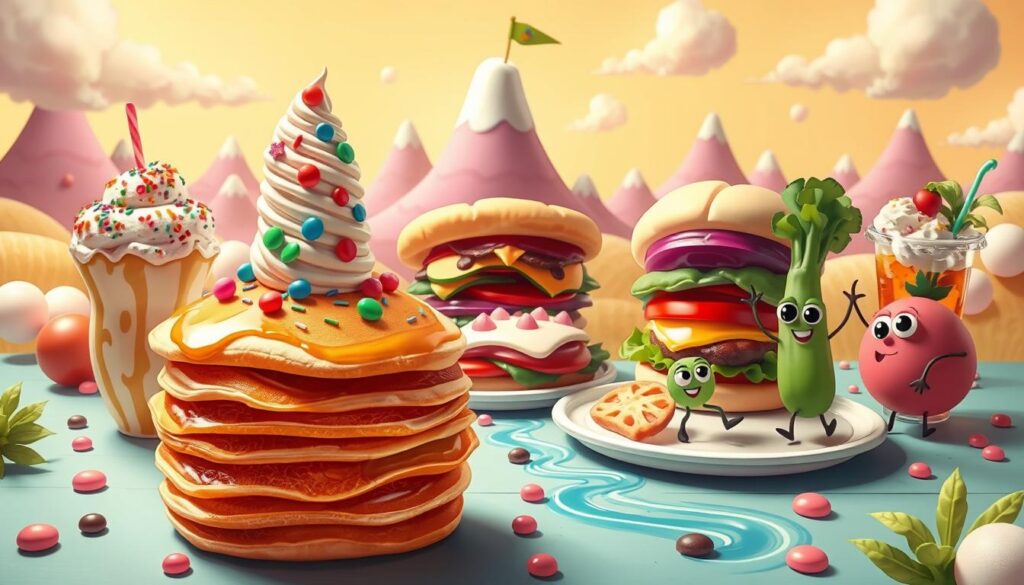
These cartoon creations have influenced not only our pop culture landscape but also real-world food marketing and product development. By examining these animated foods, we can gain insight into how they continue to shape our perceptions of food and dining experiences.
The Science of Fictional Foods in Literature
The science behind fictional foods in literature is a complex and intriguing topic that warrants exploration. We examine how fantasy authors use food as part of worldbuilding, creating unique cuisines that reflect their fictional cultures and environments.
Food as Character Development in Classic Novels
In classic novels, food often plays a significant role in character development. For instance, the stockpiled gourds and braids of garlic in the Ingallses’ attic, described in the Little House series, reveal the family’s resourcefulness and rural lifestyle. Such descriptions provide insight into the characters’ backgrounds and personalities.
Symbolic Meals in Fantasy Literature
Symbolic meals are another crucial aspect of fantasy literature. In works like The Chronicles of Narnia, feasts often represent celebration, comfort, or temptation. For example, the roast fowl and venison feasts symbolize abundance and joy, drawing characters and readers into the world of Narnia.
| Literary Work | Fictional Food | Symbolism |
|---|---|---|
| The Chronicles of Narnia | Roast fowl and venison feasts | Abundance, joy, celebration |
| Little House series | Stockpiled gourds and braids of garlic | Resourcefulness, rural lifestyle |
Famous Fictional Foods from Film
Movie magic often conjures up fictional foods that are as memorable as they are mouth-watering. These culinary creations not only enhance the cinematic experience but also leave a lasting impression on audiences.

Big Kahuna Burger from Pulp Fiction
The Big Kahuna Burger, featured prominently in Pulp Fiction, is more than just a meal; it’s a cultural reference point. This fictional fast-food chain has become synonymous with the film’s quirky dialogue and memorable characters. The mention of Big Kahuna Burger adds to the movie’s tension and release, showcasing how food can be used as a narrative device.
The $5 Milkshake and Other Cinematic Treats
The $5 milkshake from Pulp Fiction is another iconic food moment that has captured the public’s imagination. This scene not only highlights the film’s non-linear storytelling but also showcases how food can be used to convey character traits and establish relationships. Other films have followed suit, using food to create memorable moments that resonate with audiences.
Animated Feasts That Looked Too Good to Be Real
In the realm of animation, food is not just sustenance; it’s a character, a plot device, and a feast for the eyes. Disney has a long history of creating tantalizingly beautiful animated food that captivates audiences. One of the most iconic examples is the “Be Our Guest” sequence from Beauty and the Beast, where the enchanted dinnerware and sumptuous feast come to life in a spectacular display.
Cinematic Culinary Art
Ratatouille’s culinary masterpieces are a testament to the artistry of Pixar animators. The film’s depiction of Gusteau’s Parisian restaurant, with its intricate dishes and vibrant colors, showcases the importance of food in storytelling. The movie uses food to represent comfort, community, and creativity, making the culinary experience feel both authentic and fantastical.
- The film’s attention to detail in cooking techniques and kitchen dynamics adds depth to its narrative.
- Ratatouille elevates food to a central theme, exploring the connection between cuisine and culture.
Disney’s Most Mouth-Watering Moments
Disney’s portrayal of food has evolved significantly over time, reflecting changing animation technologies and cultural attitudes. From Snow White‘s poisoned apple to The Princess and the Frog‘s beignets, Disney’s animated feasts are not just visually stunning; they often combine visual appeal with musical numbers, creating particularly memorable sequences. These moments make the food feel like a character in its own right, leaving a lasting impression on viewers.
The Psychology Behind Fictional Foods
The world of fictional foods is not just about fantasy; it’s deeply rooted in the psychology of how we experience and remember food. When we encounter fictional foods in literature, film, or television, they often become intertwined with our memories of those experiences, creating powerful emotional connections.
Our fascination with fictional foods can be attributed to several psychological factors. One key aspect is the nostalgia they evoke. Fictional foods often represent a simpler time or a comforting memory from our past, much like comfort foods do in real life.
Why We Crave What Doesn’t Exist
We crave fictional foods for various reasons, including the emotional and sensory experiences they evoke. These foods often symbolize more than just sustenance; they represent experiences, emotions, and connections to others. For instance, the idea of enjoying a meal together is a universal human experience that fictional foods can tap into, evoking feelings of warmth and togetherness.
Moreover, fictional foods allow us to explore different culinary possibilities without the constraints of reality. They enable us to imagine alternative culinary experiences, which can be particularly appealing in the context of escapism or when exploring new ideas.
Nostalgia and Food Memory in Fiction
Nostalgia plays a significant role in our connection to fictional foods. When we revisit fictional foods from our past, it triggers a powerful nostalgic response. This nostalgia is not just about the food itself but about the memories and experiences associated with it.
Research into food memory helps explain why fictional foods can have such a lasting impact on our psyches. The emotional and sensory aspects of experiencing fictional foods can become deeply ingrained in our memory, influencing our preferences and expectations around real food.
| Psychological Aspect | Description | Impact on Food Preferences |
|---|---|---|
| Nostalgia | Emotional connection to past experiences | Influences adult food preferences |
| Emotional Connection | Association with memories and emotions | Shapes expectations around real food |
| Sensory Experience | Imagination of taste, smell, and texture | Enhances appeal of similar real foods |
By understanding the psychological aspects behind our fascination with fictional foods, we can gain insights into how they influence our relationship with food in real life. This connection highlights the complex interplay between our imagination, memory, and culinary experiences.
Recreating Fictional Foods in Real Life
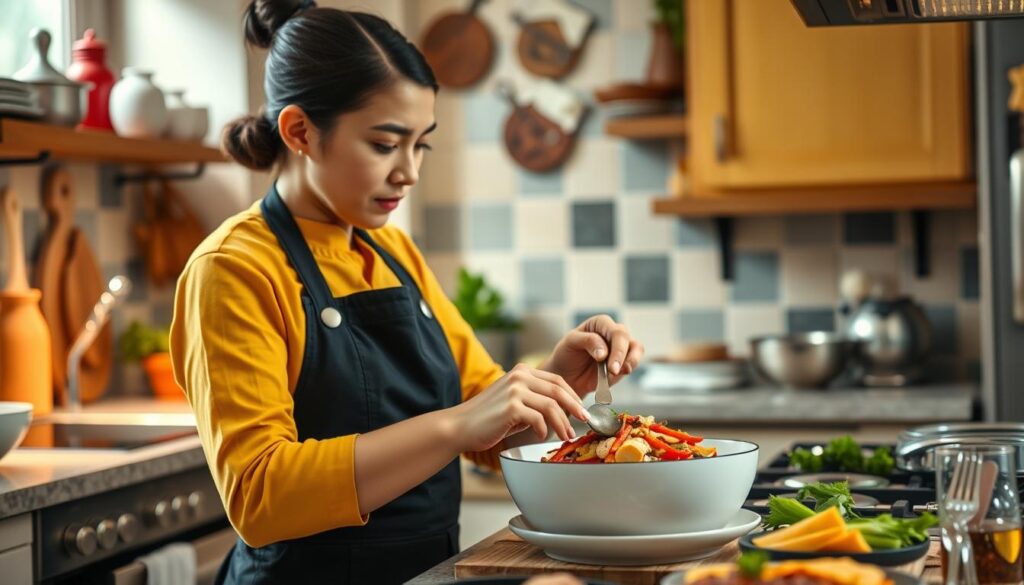
The art of turning fictional cuisine into real-life dishes has gained significant traction among food enthusiasts and fans alike. We see a growing community of home chefs who specialize in recreating fictional food from books, movies, and TV shows.
Theme Parks and Official Recreations
Theme parks and official recreations play a significant role in bringing fictional foods to life. For instance, Universal Studios has successfully recreated iconic dishes from popular franchises, such as the Wizarding World’s Butterbeer.
Home Chefs Tackling Imaginary Recipes
Home chefs are also making significant contributions by experimenting with and sharing their own versions of fictional recipes. Social media platforms have become essential for sharing these creations, with food bloggers and cookbook authors providing inspiration and guidance. The work of translating fictional foods into real recipes requires both culinary skill and interpretive imagination.
Iconic Fictional Foods from Television Shows
The world of television is rich with fictional foods that not only entertain us but also inspire real-world culinary trends. These foods often become ingrained in our culture, symbolizing the shows they come from.
The Simpsons’ Culinary Universe
The Simpsons is renowned for its wide array of fictional foods, with Donuts being a staple in the characters’ diet. The show’s portrayal of food often parodies American cuisine and culture, making it a rich source of satire.
Spaghetti Tacos and Other TV Food Phenomena
Shows like iCarly have given us the infamous Spaghetti Tacos, a dish that, despite being fictional, has inspired real-world recipes. Other shows, such as Friends, have made pizza a central part of their narrative, often referencing it as a comfort food. These foods become a thing among fans, representing a shared cultural experience tied to the show.
The Art of Designing Fictional Foods
Creating believable and appetizing fictional foods is a challenge that requires both creativity and technical skill. The art of designing these culinary creations involves a deep understanding of food, culture, and visual storytelling. Whether in literature, film, or animation, fictional foods captivate audiences and enhance the narrative.
Designing fictional foods is not just about making them look appealing; it’s also about making them believable within their fictional context. A richly detailed food culture can elevate a story, making the world feel more immersive and real.
Food Stylists and Special Effects in Film
Food stylists play a crucial role in making fictional foods look real on screen. They use a combination of culinary expertise and special effects to create dishes that are not only visually stunning but also tell a story. For instance, the chocolate river in adaptations of Charlie and the Chocolate Factory requires a deep understanding of both chocolate and special effects to achieve the right consistency and appearance.
Illustrators and Animators Creating Delicious Visuals
Illustrators and animators use various techniques to make fictional foods appealing. They employ color theory, texture rendering, and visual exaggeration to create mouth-watering images. Digital animation has transformed the way fictional foods are visualized, allowing for more realistic physics and textures. A small bit of artistic detail can make a significant difference in how appetizing the food appears.
| Technique | Description | Example |
|---|---|---|
| Color Theory | Using colors to evoke emotions and appetite | The vibrant colors of the sweets in Willy Wonka’s factory |
| Texture Rendering | Creating realistic textures to make food look edible | The detailed texture of the Krabby Patty in SpongeBob SquarePants |
| Visual Exaggeration | Exaggerating food features to make it more appealing | Oversized desserts in animated movies |
Dystopian and Sci-Fi Food Concepts
Fictional foods in sci-fi and dystopian settings not only tantalize our taste buds but also prompt us to think critically about our relationship with food. As we explore these culinary concepts, we gain insights into the societal commentary they offer.
These narratives often use food as a lens through which we can examine our hopes and fears about the future. At one end of the spectrum, we have dystopian visions like Soylent Green, which challenges our perceptions of sustenance and survival.
Soylent Green and Disturbing Food Futures
Soylent Green, a 1973 film, presents a grim future where food production has become a critical issue. The movie’s portrayal of a population surviving on processed food wafers made from recycled sources serves as a stark warning about the dangers of unchecked population growth and resource depletion. This concept has become a cultural touchstone, symbolizing the potential dark side of food technology.
Star Trek’s Food Replicators and Futuristic Dining
In contrast, Star Trek offers an optimistic vision of the future with its food replicators, which can produce any dish on demand, eliminating scarcity and labor associated with food preparation. This concept has inspired real-world innovations in food technology. Additionally, Star Trek has introduced us to intriguing alien cuisines, such as Romulan Ale and Raktajino, which have become beloved by fans. These fictional foods not only enrich the Star Trek universe but also reflect our aspirations for a future where time is spent on enjoyment rather than drudgery, making mealtime a significant part of our social interactions.
Children’s Literature and Memorable Fictional Foods
From Roald Dahl’s edible inventions to Dr. Seuss’s Green Eggs and Ham, fictional foods in children’s literature have captivated readers of all ages. These imaginative culinary creations not only tantalize our taste buds but also serve as vehicles for teaching valuable life lessons.
We examine how these fictional foods are used in children’s literature to introduce concepts such as choice, preference, and cultural diversity. For instance, Dr. Seuss’s Green Eggs and Ham uses food as a visual device to teach about prejudice and openness to new experiences. The simple concept of colored eggs became one of the most recognized fictional foods on any list of memorable food moments.
Roald Dahl’s Edible Worlds
Roald Dahl’s works are renowned for their vivid descriptions of fantastical foods. His stories often feature edible inventions that not only spark imagination but also convey moral lessons. For example, the Everlasting Gobstoppers and the lickable wallpaper in Charlie and the Chocolate Factory teach children about the consequences of their actions and the value of moderation.
Green Eggs and Ham and Other Childhood Classics
Other childhood classics, such as The Very Hungry Caterpillar and Cloudy with a Chance of Meatballs, also feature food prominently. These stories use food to create accessible narratives about complex social and emotional concepts. They help children develop a healthy relationship with food and foster a sense of curiosity about the world around them.
By analyzing these works, we can gain insight into how fictional foods in children’s literature create lasting food memories that influence adult relationships with cuisine. These stories not only entertain but also educate, making them a valuable part of a child’s literary journey.
The Cultural Significance of Fictional Foods
Fictional cuisine is not just a product of an author’s imagination; it serves as a reflection of our real-world culinary practices, societal values, and cultural norms. In the realm of fiction, food is not just sustenance but a tool for social commentary, cultural reflection, and culinary innovation. By examining the role of food in fiction, we can gain insights into our collective attitudes towards cuisine, culture, and society.
Reflection of Real-World Cuisine
Fictional foods often mirror the culinary practices and preferences of the real world, albeit with imaginative twists. We observe how different fictional cuisines reflect the cultural heritage and societal values of their respective fictional worlds. For instance, the depiction of feasts in fantasy literature can echo historical banquet traditions, while futuristic foods in science fiction may comment on contemporary concerns about sustainability and technological advancements in food production.
Food as Social Commentary
Beyond mere reflection, fictional foods are frequently used as a vehicle for social commentary. Authors and creators utilize food to critique or highlight issues such as class inequality, environmental degradation, and the ethics of technological innovation. For example, the portrayal of food scarcity or excess in dystopian fiction often serves as a commentary on current societal trends and potential future consequences. By analyzing these depictions, we can better understand the cultural significance of food in both fiction and reality, across different times and cultures.
Moreover, the way food is marketed, consumed, and shared in fictional narratives can satirize real-world consumer culture and societal norms. This not only provides commentary on our current world but also prompts reflection on our values and practices regarding food and community.
The Most Influential Fictional Foods in Pop Culture

From Willy Wonka’s chocolate factory to the wizarding world’s butterbeer, fictional foods have left a lasting impact on our collective imagination. These culinary creations have not only captured our hearts but have also influenced real-world products and experiences.
Fan-Favorite Fictional Dishes
Fictional foods like Wonka chocolate and Krabby Patties have become fan favorites, symbolizing the creativity and appeal of their respective stories. These dishes often inspire fan art, cosplay, and even real-world cooking attempts.
Foods That Transcended Their Original Stories
Some fictional foods have transcended their original narratives, becoming cultural references that are widely recognized. For instance, Willy Wonka’s chocolate concepts have influenced candy marketing and product development for decades, demonstrating the lasting impact of fictional cuisine on our culture.
Why We’ll Always Hunger for Fictional Foods
As we conclude our journey through the world of fictional foods, it’s clear that these culinary creations continue to captivate us day after day. Fictional foods represent our idealized relationship with eating, where every meal is perfect, every sauce is balanced, and every bite is satisfying. They allow us to experience the taste of the impossible without calories, preparation time, or cleanup. Our lifelong relationship with fictional foods creates a shared cultural vocabulary and reference point, often symbolizing comfort, adventure, status, or rebellion.
The unattainability of fictional foods paradoxically makes them more appealing, as we can imagine them exactly as we’d like them to be. They represent our desire for simplicity and clarity in an increasingly complex food landscape. The perfect crunch, the ideal cheese pull, and the satisfying stuff between our teeth in fictional foods are experiences that rarely align in reality. As we reflect on the influence of fictional dishes, it’s evident that they will continue to inspire real culinary innovation and personal food memories for generations to come.
